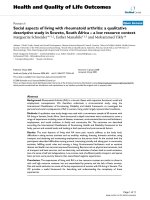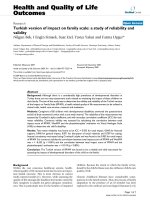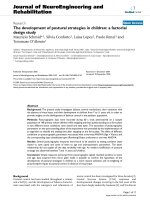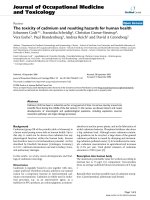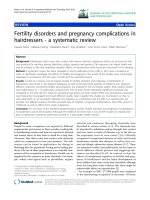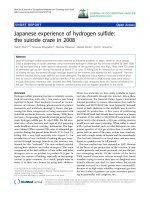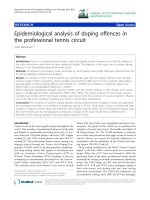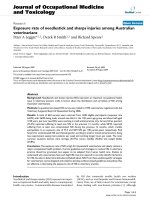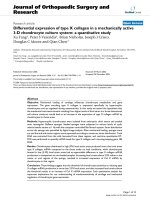báo cáo hóa học:" Nonoperative treatment of slipped capital femoral epiphysis: a scientific study" ppt
Bạn đang xem bản rút gọn của tài liệu. Xem và tải ngay bản đầy đủ của tài liệu tại đây (1.36 MB, 11 trang )
RESEARCH ARTICLE Open Access
Nonoperative treatment of slipped capital
femoral epiphysis: a scientific study
Pedro Carlos MS Pinheiro
Abstract
Background: Treatment of the Slipped Capital Femoral Epiphysis remains a cause of concern due to the fact that
the true knowledge of the etiopathogeny is unknown, as well as one of its major complications: chondrolysis. The
conservative treatment remains controversial; it has been overlooked in the studies and subjected to intense
criticism. The purpose of this study is to investigate the results of treatment on the hip of patients displaying
slipped capital femoral epiph ysis, using the plaster cast immobilization method and its link to chondrolysis.
Methods: The research was performed based on the study of the following variables: symptomatology, and the
degree of slipping. A hip spica cast and bilateral short/long leg casts in abduction, internal rotation with anti-
rotational bars were used for immobilizing the patient’s hip for twelve weeks. Statistical analysis was accomplished
by Wilcoxon’ s marked position test and by the Fisher accuracy test at a 5% level.
Results: A satisfactory result was obtained in the acute group, 70.5%; 94%; in the chronic group (chronic + acute
on chronic). Regarding the degree of the slipping, a satisfactory result was obtained in 90.5% of hips tested with a
mild slip; in 76% with moderate slip and 73% in the severe slip. The statistical result revealed that a significant
improvement was found for flexion (p = 0.0001), abduction (p = 0.0001), internal rotation (p = 0.0001) and external
rotation (p = 0.02). Chondrolysis was present in 11.3% of the hips tested. One case of pseudoarthrosis with aseptic
capital necrosis was presented. There was no significant variation between age and chon drolysis (p = 1.00).
Significant variation between gender/non-white patients versu s chondrolysis (p = 0.031) and (p = 0.037),
respectively was verified.
No causa l association between plaster cast and chondrolysis was observed (p = 0.60). In regard to the
symptomatology group and the slip degree versus chondrolysis, the p value was not statistically significant in both
analyses, p = 0.61 and p = 0.085 respectively.
Conclusions: After analyzing the nonoperative treatment of slipped capital femoral epiphysis and chondrolysis, we
conclude that employment of the treatment revealed that the method was functional, efficient, valid, and
reproducible; it also can be used as an alternative therapeutic procedure regarding to this specific disease.
Background
The contributions and reasons for the use of the non-
operative management of Slipped Capital Femoral Epi-
physis (SCFE) are as follows:
- applicability: non-operative treatment of SCFE
allows the use of this method at any hospital, even for
surgeons who have very little hands-on e xperience with
this specific disease;
- elucidation: the work elucidates the employment of
a princip le and the met hod of treatment lit tle exploited
by world literature;
- knowledge: this research offers the opportunity for
orthopedic surgeons to employ a method based o n biol-
ogy, contributing to further knowledge of SCFE, thereby
also promoting the possibility of a wide debate on the
subject;
- repr oducible: the easy use of this method allows the
treatment to be repeated in other innovating medicine
centers by an execution of a general procedure to a
widespread application, adding value to knowledge;
Correspondence:
Post-Graduation Departament of the Federal University of Rio de Janeiro,
(UFRJ) and Jesus Children’s Hospital, Rio de Janeiro, Brazil
Pinheiro Journal of Orthopaedic Surgery and Research 2011, 6:10
/>© 2011 Pinheiro; licensee BioMed Central Ltd. This is an Open Access article distributed under the terms of the Creative Commons
Attribution License (http://cre ativecommons.org/licenses/by/2.0), which pe rmits unrestricte d use, distribution, and reproduction in
any mediu m, provided the original work is properly cited.
- results: the work has proven its effectiveness based
on statistical data obtained, thereby demonstrating its
importance and feasibility;
- therapeutic: the use of the plaster cast method
revealed the possibility of obtaining favorable results for
its use;
- prognosis: early diagnosis, associated with the sim-
plicity of the SCFE method, favors a good prognosis and
low morbidity for the disease.
This work posits that the benefits and application of
the therapeutic criteria based on bio logy comprise a
valid method of treatment, considering disease prognos-
tic uncertainty.
Patients and Methods
The Committee of Ethics of the Jesus Children’sHospi-
tal in Brazil, Rio de Janeiro, have analyzed and approved
the Research Project entitled, Nonoperative treatment of
slipped capital femoral epiphysis, which was also evalu-
ated by the Ethics Committee for Research of the Fed-
eral University of Rio de Janeiro (UFRJ), Brazil.
The typology of the design employed in this sample
was a study of a single cohort with observational, longitu-
dinal and retrospective characteristics. In this research,
chondrolysis was the dependent variable. A consecutive
series of 106 hip joints in eighty-four patients affected,
the great majority of them obese, displaying SCFE, were
treated by means of plaster cast (Table 1 and Table 2).
Patients’ age varied at the time of diagnosis, ranging from
7.6 to 15.8 years. The duration o f the follow-up ranged
from 12 months, with the complete growth-plate closure,
to 146 months, an average of 51 months. Thirteen
patients were younger than eleven, 55 patients were
between the ages of 11 and 13; and 16 patients were
between the ages of 13 and 16. The average age was 12.5,
males having the average age of 14.5 and females 10.5.
Forty-four patients were males, and 40 females. Regard-
ing race, 43 were white, and 41 were non-white. Unilat-
eral involvement was present in 62 left hips and 44 right
hips. Bilateral displacement (simultaneous involvement)
of hips was present in 19 patients. Three patients were
detected as displayin g involveme nt of the contra lateral
hip in diffe rent periods (sequential bilaterality), compris-
ing, in total, 22 bilateral slip patients.
The methods used were evaluated based on sympto-
matology, and categorized as acute, chronic, or acute on
chronic, according to Fahey and O’Brien [1]; also, slip
degrees were documented by the standard method of
thirds and classified as mild, moderate, or severe,
according to Wilson, Jacobs, Schecter [2]; MacEwen and
Ramsey who use the three grades of slip percentage [3].
The hips were systematically eval uated roentgenographi-
cally, as well as functionally, according to Heyman and
Herndon’ s criteria [4], being also categorized as
satisfactory and unsatisfac tory by means of Aadalen,
Weiner, Hoyt, Herdon and Herdon’ s criteria [5]. The
radiographic methods used to analyze joint cartilage and
detect chondrolysis were based on Ingram, Clarke, Clark
and Marshall’s criteria [6].
Treatment Protocol
The main objective of the SCFE treatment is to avoid
progressive displacement, with the use of the safest and
the most effective techniq ue to arrest growth plate. The
routine methodology employed was based on the con-
servative princip le with the use of spicas (earlier cases)
and bilateral short/long leg casts in abduction, and a
slight internal rotation (15°) with antirotational bars
(later cases), aiming at immobilizing the patient’s hip for
12 weeks.
Skin traction was used in order to avoid slip progres-
sion pre-casting in those patients displaying muscle
spasms. Traction was also used to limit the patient’ s
motion in order to reduce pain, and to prevent irritabil-
ity (pain when moved through passive or active range of
motion) [7]. Skelet al traction was also applied. This type
of traction was used in these patients in an attempt to
improve t he neck-femoral head relationship. Reduction
of the degree of slip by skeletal traction was not found
in this series. For this reason, this type of traction was
abandoned in SCFE pre-treatment.
Anaesthesia was administered as needed in the pre-
sence of pain and/or discomfort during plaster hip spica
and short/long-leg cast application, in preparation for
resting the hip.
Manipulation under a nesthesia was per formed as an
alternative procedure to improve epiphysis position. In
very few cases, Leadbetter’s maneuver was gently applied
prior to cast application, with the intention of improving
the displacement of the neck/femo ral head relationship,
this being carefully carried out in chosen hips [8].
Cast immobilization was carried out for 12 weeks, in
accordance with the casting protocol. No weightbearing
was permitted during the “ casting perio d”.Ahipspica
was used in earlier cases; as time went on, and we gained
more “ experience” in the matter, choice was made of
changing the method of plaster ing to short leg casts, on
account of this being an easier application, allowing the
patients to set hips and knees into motion in flexion and
extension, thus p erforming mu scle exercises (dynamic
method). This type of immobilization was based on
King’ s w ork, being also used to facilitate the patient’ s
movement in a wheelchair [9].
The criteria adopted for interruption of the plaster
cast use were based on the physeal stability of the head
with the femoral neck in the a ffected hip. Stability,
which is the ability to walk without hip pain, was
reached regardless of the progress and stage of the
Pinheiro Journal of Orthopaedic Surgery and Research 2011, 6:10
/>Page 2 of 11
Table 1 Data on the Patients
Case Age at
Diagnosis
(Yrs.)
Sex* Race
#
Hip
Treated
¥
Classification Grade of
Slip
Type of
Traction
Time
in cast
(Days)
Type of cast Follow-up
Analysis
(Months)
1 11.8 F N-W R Chronic Mild Skin 198 1 1/2 Spica 144
2 11.6 F N-W L Chronic Mild - 106 1 1/2 Spica 96
3 10.6 M W L Chronic Mild - 93 1 1/2 Spica 66
F 11 W R+L Acute,
Acute
Severe,
Severe
Skin
Skin
84 Double Spica 116
116
5 12.1 F N-W L Acute Moderate Skin 114 Double Long Leg Casts 60
6 12.6 F N-W L Chronic Mild Skin 119 1 1/2 Spica 144
7 9.10
11.3
F W R+L Acute,
Acute
Mild,
Mild
Skin,
Skin
84,
84
1 1/2 Spica,
1 1/2 Spica
126
108
8 13 M N-W L Chronic Severe Skeletal 90 1 1/2 Spica 50
9 12.2 F W R Chronic Mild Skin 119 1 1/2 Spica 60
10 11.4 F N-W R Chronic Mild Skin 119 1 1/2 Spica 57
11 12 F N-W L Acute Mild Skin 91 1 1/2 Spica 52
12 11 F N-W R Chronic Moderate Skin 77 1 1/2 Spica 84
13 11.7 F N-W R Acute Moderate Skin 84 1 1/2 Spica 146
14 12.8 M W R Chronic Mild Skin 105 1 1/2 Spica 12
15 13.10 M N-W L Chronic Mild Skin 84 1 1/2 Spica 118
16 10.2 F N-W R+L Acute,
Chronic
Mild,
Mild
_
_
91 Double Spica 45
45
17 12 M N-W R Chronic Moderate - 91 1 1/2 Spica 58
18 11.9 F N-W R+L Chronic,
Chronic
Mild,
Moderate
Skin,
Skin
84 Double Spica 12
12
19 14 M N-W L Chronic Moderate Skin 101 1 1/2 Spica 43
20 12.2 F N-W R Chronic Mild - 84 1 1/2
Spica 65
21
12.6 M W R+L Chronic,
Chronic
Moderate,
Moderate
Skin,
Skin
84 Double Spica 48
48
22 8.3 M W L Chronic Mild Skin 119 1 1/2 Spica 32
23 10.8 F NW L Chronic Mild Skin 84 1 1/2 Spica 76
24 12.1 F W R+L Chronic,
Chronic
Mild,
Moderate
Skin,
Skin
98 Double Spica 41
41
25 9 F N-W R Chronic Mild Skin 84 1 1/2 Spica 75
26 12.5 F W L Acute on Chronic Mild Skin 84 1 1/2 Spica 23
27 12.8 M N-W R+L Acute,
Acute
Mild,
Moderate
Skin,
Skin
84 Double Spica 71
71
28 11.10 F N-W R Acute Mild Skin 84 1 1/2 Spica 70
29 13.5 M N-W R+L Chronic,
Chronic
Mild,
Moderate
Skin,
Skin
84 Double Spica 28
28
30 11.5 F N-W R+L Chronic,
Chronic
Mild,
Mild
Skin,
Skin
84 Double Spica 78
78
31 14 M W R Chronic Mild - 84 1 1/2 Spica 35
32 11.6 F W L Chronic Mild - 84 1 1/2 Spica 25
33 10.8 F W L Chronic Moderate - 84 1 1/2 Spica 68
34 14 M W L Chronic Mild - 84 1 1/2 Spica 122
35 11.8 M W L Acute on
Chronic
Severe - 80 1 1/2 Spica 56
Pinheiro Journal of Orthopaedic Surgery and Research 2011, 6:10
/>Page 3 of 11
Table 1 Data on the Patients (Continued)
36 12 F N-W R Chronic Mild - 81 1 1/2 Spica 130
37 9.7 F N-W R Chronic Mild - 80 1 1/2 Spica 48
38 11.8 M W L Acute Mild - 88 1 1/2 Spica 48
39 12.1 M N-W R+L Chronic,
Chronic
Mild,
Mild
-88
88
1 1/2Spica,
Bilateral Short Casts
46
12
40 13 M W R Chronic Mild - 83 1 1/2 Spica 50
41 11.9 F W R+L Chronic,
Chronic
Mild,
Mild
-
_
85 Double spica 81
81
42 14.5 M W L Chronic Mild - 84 1 1/2 Spica 13
43 11.9 M N-W L Chronic Mild - 84 1 1/2 Spica 45
*M = male and F = female; # W = white and N-W = non-white; ¥ R = right and L = left.
Table 2 Data on the Patients
Case
Age at
Diagnosis
(Yrs.)
Sex* Race
#
Hip
Treated
¥
Classification Grade of
Slip
Type of
Traction
Time
in cast
(Days)
Type of cast Follow-up
Analysis
(Months)
44 13 M W R+L Chronic,
Chronic
Severe,
Mild
Skeletal,
Skin
84 Double Spica 12
12
45 12 M W L Chronic Mild - 84 1 1/2 Spica 45
46 11.7 F N-W L Chronic Severe - 88 1 1/2 Spica 44
47 11.4 M W L Chronic Mild - 84 1 1/2 Spica 48
48 12.6 F N-W R Chronic Mild - 90 1 1/2 Spica 30
49 12.2 M W R+L Chronic,
Chronic
Severe,
Mild
Skeletal
_
93
90
1 1/2Spica,
Bilateral Short Casts
50
36
50 11.8 M W L Chronic Mild - 84 1 1/2 Spica 36
51 11.3 F W R+L Chronic,
Chronic
Mild,
Mild
- 84 Double Spica 34
34
52 12 F N-W R Chronic Mild - 84 1 1/2 Spica 36
53 12 F W R+L Chronic,
Chronic
Mild,
Moderate
-
_
95 Double Spica 12
12
54 14.3 M N-W L Chronic Mild - 84 1 1/2 Spica 16
55 11 M N-W L Chronic Mild - 88 1 1/2 Spica 64
56 11.3 F W L Chronic Moderate - 89 1 1/2 Spica 50
57 12 F W R Acute on
Chronic
Mild - 84 1 1/2 Spica 37
58 7.6 M N-W R Acute Mild - 87 Bilateral Short Casts 94
59 12.9 M N-W R+L Chronic,
Chronic
Mild,
Mild
- 82 Double Spica 19
19
60 11.8 F W L Acute Mild - 87 Bilateral Short Casts 18
61 11.8 M N-W L Chronic Mild - 106 Bilateral Short Casts 52
62 11.7 M W R+L Chronic,
Chronic
Mild,
Severe
- 94 Bilateral Short Casts,
Bilateral Long Leg Casts
13
13
63
13 M N-W R Chronic Mild - 94 Bilateral Short Casts 13
64 11.2 F W R Chronic Mild - 84 Bilateral Short Casts 48
65 11.4 M W L Chronic Mild - 87 Bilateral Short Casts 50
66 13 M N-W L Acute on Chronic Severe - 92 Bilateral Short Casts 43
67 9.9 F N-W R+L Chronic,
Chronic
Mild,
Mild
-90
90
Bilateral Short Casts 12
68 11.10 F N-W R Chronic Moderate - 87 Bilateral Short Casts 12
69 13.6 M W L Chronic Mild - 90 Bilateral Short Casts 36
Pinheiro Journal of Orthopaedic Surgery and Research 2011, 6:10
/>Page 4 of 11
growth-plate closure (12 weeks). Follow-up was per-
formed every three months to monitor the growth plate
closure (Figure 1).
For patients who developed chondrolysis, the t reat-
ment protocol for the hip was as follows: analgesics,
skin traction, bed rest, gentle active range-of-motion
exercises, hydrotherapeutic/physiotherapeutic program,
and the use of crut ches (prolonged and nonweightbear-
ing). The patients who presented chondrolysis under-
went an observation period which took from 3 (three)
to 12 (twelve) months; the criterion to stop the treat-
ment for chondrolysis was opted for when irreversible
clinical range of motion and deformation of both the
femoral head and acetabulum were detected.
Results
The results of the spica treatment (69%) and bilateral
short/long leg casts (31%) in abduction and internal
rotation with anti-rotational bars were evaluated func-
tionally as well as roentgenographically according to
Heyman, Herdon [4], A adalen, Weiner, Hoyt, Herdon
and Herdon’s methods and criteria [5]. A 70.5% satisfac-
tory result was obtained in the acute group, 94% in the
chronic group (chronic + acute-on-chronic). Regarding
the degree of the slipping, a satisfactory result was
obtained in 90.5% of hips with a mild slip, 76% of hips
with a moderate slip and 73% of hips with a severe slip.
It became necessary to reapply a new cast (re-
displacement), after the established pr otocol (1 2 weeks),
in six (5.6%) patients (Cases 25, 27, 63, 64, 74, and 75),
who presented a second slip (average : 11 months after
cast was discontinued) (Table 3).
In 106 analyze d hips, 12 (11.3%) were detected with
chondrolysis, clinically diagnosed by pain, limp, muscle
spasms, stiffness, mobility limitations and narrowing of
the hip joints’ spac e, as radiographically determine d.
Among 44 males, only two (Cases 54 and 82) presented
chondrolysis, and, in 40 females, eight (Cases
1,2,5,6,13,18,53 and 67) also displayed the same problem
(Table 4). Among twelve hips with chondrolysis, four
(33% [Cases 2, 5, 6, and 82]) presente d transient chon-
drolysis, joints had widene d close to normal, osteopenia
had improved and pain an d stiffness ha d decrease d dur-
ing the follow-up period (Figure 2).
Regarding race types, there were 43 white SCFE
patients. Only two (Cases 54 and 82) displayed chondro-
lysis. Among 41 non-white patients, eight (Cases 1, 2, 5,
6, 13, 18, 54 and 67) also presented chondrolysis. Seven
ofthese(Cases1,2,5,6,13,18,and67)werefemale
patients, and one was a male (Case 54).
Table 2 Data on the Patients (Continued)
70 10.5 M W R Acute Mild - 90 Bilateral Short Casts 72
71 12.6 M W R Chronic Moderate - 90 Bilateral Short Casts 12
72 12.1 F W R+L Chronic,
Chronic
Mild,
Mild
-93
93
Bilateral Short Casts 74
73 11.4 M W R+L Chronic,
Chronic
Mild,
Mild
- 91 Bilateral Short Casts 70
74 11.5 M W L Chronic Mild - 97
93
Bilateral Short Casts 58
75 12.10 F N-W L Acute Severe Skeletal 90 Bilateral Short Casts 45
76 12.8 F W L Chronic Moderate - 100 Bilateral Short Casts 38
77 15.8 M W L Chronic Moderate - 90 Bilateral Short Casts 54
78 11.8 M W R+L Chronic,
Chronic
Mild,
Moderate
-90
90
Bilateral Short Casts 20
79 13.7 M N-W L Chronic Severe Skeletal 107 Bilateral Short Casts 42
80 15.6 M W L Chronic Moderate - 90 Bilateral Short Casts 12
81 12.8 F N-W L Chronic Mild - 101 Bilateral Short Casts 37
82 13.9 M W R+L Chronic,
Chronic
Moderate,
Mild
-90
90
Bilateral Short Casts 14
83 12.7 M W L Acute Mild - 90 Bilateral Short Casts 25
84 14 M N-W L Chronic Mild - 97 Bilateral Short Casts 33
85 14 F W No Chronic Severe - - - 48
86 11.8 F N-W No Chronic Mild - - - 72
*M = male and F = female;
#W = white and N-W = non-white;
¥ R = right and L = left.
Pinheiro Journal of Orthopaedic Surgery and Research 2011, 6:10
/>Page 5 of 11
In 19 patients (38 hips) with simultaneous involve-
ment displacement, only two patient cases, 18 and 67,
developed complications. In 44 hips with the right side
affected, only three (Cases 1, 13 and 82) presented
chondrolysis; in 62 cases on the left si de, five (Cases 2,
5, 6, 53 and 54) presented the same complication.
Regarding the type of plaster cast used and chondrolysis,
the following was observed: 1 1/2 spica - four chondrolysis
hips, cases, (1, 2, 13 and 54); double short leg casts-three
chondrolysis hips, cases (67 [both hips] and 82); double
spica - three chondrolysis hips (18 [both hips] and 53);
and double long leg casts-one chondrolysis hip (Case 5).
A B
C D
EF
Figure 1 Early slipping of the femoral epiphysis of the left hip. A cast after twelve weeks was applied. The image of the left hip shows growth
arrest andno progression with conservative management. (A and B) Anteroposterior and frog-leg lateral radiographs of the pelvis made before
treatment, showing the zone of rarefaction on the metaphyseal side in the left hip of the growth plate in Chronic/Mild SCFE, in a ten and half year old
boy. (C and D) Anteroposterior and frog-leg lateral radiographs eight months after spica cast had been discontinued. The rarefaction zone has
diminished and persists in the left hip. (E and F) Final result. The growth-plate has completely closed on both radiographs of the left hip.
Table 3 Distribution of the results of the six patients who presented a re-displacement (Progression cases after cast
discontinued)
Cases Age Sex Race Hip Physis Stage Type of cast Time in Cast
25 10+07 Female Non-White Right Open 1 1/2 Spica 84
27 13+11 Male Non-White Right Open Double Spica 84
63 12+01 Female White Right Open Short Leg Casts 84
64 12+01 Female White Right Open Short Leg Casts 84
74 13+04 Male White Left Open Short Leg Casts 97
75 13+06 Female Non-White Left Open Long Leg Casts 90
Pinheiro Journal of Orthopaedic Surgery and Research 2011, 6:10
/>Page 6 of 11
There were 17 hips with symptoms classified as acute,
two (Cases 5 and 13), displayi ng chondrolysis, only ten
hips (Cases 1, 2, 6, 18 [both hips], 54, 67 [both hips], 53
and 82) from 85 pertaining to the chronic group devel-
oped chondrolysis.
Seventy-four displacements were observed in the mild-
degree group. Se ven hips ( Cases 1, 2, 6, 18, 54, and 67
[both hips]) presented chondrolysis; in the moderate
degree, 5 out of 21 hips (Cases 5, 13, 18, 53 and 82)
presented c hondrolysis, and none of the nine hips with
a se vere degree developed it. Avascular necrosis was not
detected in none of the hips manipulated, by the Lead-
better maneu ver [8] (Figure 3). Two patients with SCFE
(Cases 85 and 86) were excluded from the study as
these had the epiphyseal line already closured in the
first appointment. Both patients had chondrolysis with-
out any previous kind of treatment.
One case of pseudoarthrosis (0.9%) with necrosis of
the head was detected after a repeated slip. This compli-
cation was classified as severe, of the traumatic displace-
ment type, in the patient’ s hip (Case 75), due to a
prolonged heavy femoral and tibia skeletal traction time
employed simultaneously; avascular necrosis also was
observed as a complication.
Statistical Analysis
One of the objectives of the statistical analysis was to
specify whether a significant variation existed in hip
mobility measures (in degrees) before or after treatment.
The absolute variation (in degrees) between pre-and
post-treatment is given by the following formula:
Absolute variation of flexion = flexion in post-treat-
ment-flexion in pre-treatment . Statistical analysis was
accomplished by Wilcoxon’ s marked positions test [10].
According to hip flexion analysis, significant variations
(p = 0.0001) w ere found, i. e., there was an increase of
29.5° on average after treatment. With regard to hip
abduction, a significant variation (p = 0.0001) was
found, i. e., there was an increase o f 12.5°. A s for hip
internal rotation, there were significant variations (p =
0.0001), i. e., an increase of 11.8°. Concerning hip exter-
nal rotation, significant variations (p = 0.02) were also
observed, i.e., there was an increase of 5.1°.
The other objective regarding statistical analysis was
to specify whether there existed a significant variation
between age, sex, race, an d type of immobilization ver-
sus chondrolysis. Statistical analysis was preformed by
means of Fisher’s accurate test, at 5% lev el [11]. Chon-
drolysis was present in 11.3% of the hips tested. There
was no significant variation between age and chondro-
lysis (p = 1.00). Concerning gender analysis, statisti-
cally significant variations were observed (p = 0.031).
In race analysis, there was also a statistically significant
difference (p = 0.037). No causal association between
plaster cast and chondrolysis was observed (p = 0.60).
Regarding the symptomatology group and the slip
degree versus chondrolysis, th e p value was not statisti-
cally significant in either a nalysi s, respectively p = 0.61
and p = 0.085.
Discussion
The cause of articular cartilage necrosis after slipped
capital femoral epiphysis still remains obscure [12]. Betz,
Steel, Emper, Huss and Clancy found 13.5% of chondr o-
lysis in their trials [7]. Ingram, Clarke, Clark and Mar-
shall mentioned that the incidence of chondrolysis
varies from 2% to 55% [6]. Jerre, in a series of 200
slipped femoral epiphyses treated mainly by closed
reduction and plaster immobilization, found nine hips
(4.5%) with articular cartilage necrosis [13]; in this
study, chondrolysis affected 12 hips (11.3%): four pre-
sented a temporary form of chondrolysis (7.5%), with
eight being permanent. Writings on this subject have
shown a predominance of females over males [14,15]; in
this series, chondrolysis was also predominant in
females over males.
Table 4 Chondrolysis incidence correlated to the following variables: sex, race, side, cast type, symptomatology and
slip degree
Cases Sex Race Hips Cast Type Symptomatology Slip Degree
1 Female Non-White Right 1 1/2 Spica Chronic Mild
02 Female Non-White Left 1 1/2 Spica Chronic Mild
05 Female Non-White Left Long Leg Casts Acute Moderate
06 Female Non-White Left 1 1/2 Spica Chronic Mild
13 Female Non-White Right 1 1/2 Spica Acute Moderate
18 Both Female Non-White Right +Left Double Spica Chronic Mild
53 Female White Left Double Spica Chronic Moderate
54 Male Non-White Left 1 1/2 Spica Chronic Mild
67 Both Female Non-White Right + Left Short Leg Casts Chronic Mild
82 Male White Right Short Leg Casts Chronic Moderate
Pinheiro Journal of Orthopaedic Surgery and Research 2011, 6:10
/>Page 7 of 11
According to published works [2,14,16,17]; chondroly-
sis in non-white patients (16%- 6 6%) is more common
than in white patients (2.5%). In this study, regarding
articular cartilage necrosis, it was ascertained that non-
white patients prevailed by a considerable number over
the white patients. The manifestation and prevalence of
chondrolysis as a complication in females and non-whites
are some of the unclarified points in the study as of yet.
Regarding s ymptomatology, classification in previous
studies assigns to chronic group patients the worst
I
H
G
F
EDC
B
A
Figure 2 Necrosis of the joint carti lage (Waldenström disease) of the right hip after cast pe riod. The functional value of mobility of the
affected hip was reached. Reversible clinical range of motion and deformation of both the femoral head and acetabulum were detected. (A and
B)-Anteroposterior and frog-leg lateral radiographs of the pelvis made before treatment, showing bilateral chronic SCFE, being moderate slip in
the right hip and mild in the left. (C) Anteroposterior roentgenogram of both hips after cast treatment with bilateral leg casts in abduction and
an internal rotation. We may observe narrowing and irregularity of the right hip joint with demineralization of the surrounding bone =
chondrolysis of the right hip. (D and E) Anteroposterior and frog-leg lateral radiographs of the hips showing closure of the growth-plate in the
right hip, further demineralization with obliteration of the joint space and irregularity of the head of the femur and acetabulum and also
decrease in cartilage thickness. (F and G) Anteroposterior and frog-leg lateral radiographs observing in the right hip some restoration of cartilage,
with irregular contour of the femoral head. (H and I) Anteroposterior and frog-leg lateral radiographs observing in the right hip joint, the
articular space is now widened compared to the initials X-rays. The femoral head presents mild deformity and limited range-of-motion in the
right hip.
Pinheiro Journal of Orthopaedic Surgery and Research 2011, 6:10
/>Page 8 of 11
prognosis in relation to chondrolysis [6,7,17,18]. In this
sample, the record of chondrolysis incidence in this type
of group was in accordance with the literature.
Concerning the degree of epiphysis displacement in rela-
tion to the femo ral neck, in chondrolysis, bad results are
proportional to the severity of the slip degree [6,17,18]. In
this study, seven patients classified as mild degree presented
chondrolysis, five classi fied as moderate presented the com-
plication, with none of the nine severe cases displaying it.
This finding is contrary to the general cond ition.
Nevertheless, concerning chondrolysis, there was an
inexplicable finding with one female patient who was trea-
ted for bilateral slipping by 1 1/2 spica cast. While her
right hip was normal, the left one deteriorated to
IH
F G
E C D
A B
13+ 8
13+8
Figure 3 Young female patient with severe slip of the lef t hip, treated by immobilization (anti-rotatio n plasters) after hip
manipulation. The range of motion of the left hip was normal at the final follow-up. (A and B) Anteroposterior radiograph of the pelvis and
spot film before treatment, in a nine-year-old girl who had an acute/severe slip SCFE in the left hip. (C and D) Patient under general anesthesia
submitted to gentle Leadbetter manipulation. Bilateral toe-to-groin casts had been applied. (E and F) Anteroposterior and Frog-leg lateral
radiographs showing the physis beginning the closure process in AP and lateral views. (G and H) Anteroposterior and frog-leg lateral
radiographs of the left hip, showing complete closure of the growth-plate.
Pinheiro Journal of Orthopaedic Surgery and Research 2011, 6:10
/>Page 9 of 11
chondrolysis. Necrosis of articular cartilage is an entity that
represents an auto-immune disease in genetically-suscepti-
ble individuals [19]. Still in relation to a chondrolysis com-
plication, some authors affirm that excessive
immobilization also favors articular cartilage necrosis
[13,16,20]. It was observed, in this work, that five hips out
of 12 were attacked by the disease when cast immobiliza-
tion was used for over 12 weeks (apprehension curve).
Waldenström mentioned that the collum produces
new vessels, which attempt to heal rupture continuity
[20]. The period of immobilization (12 weeks) was
observed as providing stability of the epiphysis to meta-
physis, thus avoiding displacement continuity. Ponseti
and Barta ascertained that growth plate obliteration pro-
cess hap pens between 5 and 12 months, with a 9-month
average after the beginning of the treatment with cast
immobilization [16]. In this work, growth plate ossifica-
tion time was 16.5 months.
Green found a 5% average progression of slipping after
the cast had been discontinued (one of 18 hips; this
patient’ s hip had been immobilized for only 8 weeks)
[21]. Jerre found definite redisplacement in 20 (10%)
hips in his series [13]. For prevention of additional slip
of chronic SCFE groups, Betz, Steel, Emper, Huss and
Clancy have shown effective treatment in 12 weeks, with
a spica cast [7]. They reported one progression (8 weeks
in a cast only) out of 37 hips. The range of time in
which a redisplacement is possible is claimed by Wal-
denström to be approximately 1 year [22]. Wilson
observed redisplacement occurring within 2 to
33 months (average, 11.8 months) from the start of the
treatment [23]. In the present series, out of 106 hips, six
(5.6%) were recorded with redisplacement (on average,
11 months after the cast had been removed), four fol-
lowing a traumatic episode.
King presented the use of bilateral short-leg cast
immobilization as a form of treatment without chondro-
lysis [9]. In his work, 52 affected hips were recorded
with satisfactor y results. In t he article, 33 short/long-leg
casts in abduction and internal rotation were fixed with
a stick; four chondrolysis were found, and, in 73 pl aster
spica casts, eight cases.
The disadvantages of immobilization in a spica cast
include potential skin and pulmonary problems, ileus, and
the difficulty in handling an obese child, in addition to
problems involving education [7]. These disadvantages
should be taken into consideration because of the risks of
pinning by means of wires or screws, and the serious
sequelae which include pin penetration, fracture, infection,
pin breakage, growth disturbance, wound problems, subse-
quent slippage, difficulty in pin extraction during hardware
removal, nail slipping into the joint, nail extruding, nails
bending, avascular necrosis, as well as chondrolysis
[7,14,15,24,25]. The global incidence of chondrolysis is 7%
with all forms of treatment [26]. Chondrolysis can appear
spontan eously after the slipping of the femoral epi physis
without any treatment, and may follow either a slight or a
severe slip. It may occur after any type of treatment,
whether conservative or operative [12].
Theseresultsshowwhysomemethodsareinfavor,
and others are in disfavor, in the clinic where these
patients were treated and where as, in all hospitals the
facilities and limitations must be evaluated by every sur-
geon (Clarence H. Heyman, M D) [27].
Conclusions
After analyzing the nonoperative treatment in slipped
capital femoral epiphysis and chondrolysis, we con-
cluded that the employment of the treatment revealed
that the method was func tional, efficient, valid, a nd
reproducible; it can also be used as an alternative thera-
peutic procedure regarding to this specific disease.
This manuscript is faced with the fact that the orthopae-
dic surgeons employ and evaluate a littl e-adopted treat-
ment technique by musculoskeletal studies in the
treatment of SCFE. The success or failure of treatment
intervention is determined based on the outcomes [28].
The presented work was evaluated and tested on its con-
tents, methodology and clinical usefulness. Modern medi-
cine is based on evidence, and outcomes have to have
their importance proven. The instrument of quality
employed (plaste r cast method) was assessed not only by
the s urgeon, but also by the patient, through his desc rip-
tions. The patient was always given the option, upon the
first appointment, to choose from the conservative or sur-
gical treatment. The nonoperative management of SCFE
was accepted by relatives. The interest demonstrated by
the patients in method reliability has shown the possibility
of analyzing the difference between the patients’ reports,
and those from the professionals and their studies, with
the possibility of varied outcomes. Evaluation in modern
medicine must be based on evidences of the result and on
the functional radiographic measurements, in addition to
being statistically analyzed and including the patients’
reports. The present work showed an optional method for
the treatment of slipped capital femoral epiphysis.
Consent
Written informed consent was obtained from all
patients and r elevant parents/guardians for publication
of this report and accompanying images. A copy of the
written consent is available for review by the Editor-in-
Chief of this journal.
Acknowledgements
I thank Henry R. Cowell, MD, PhD, for his review, advice, encouragement,
and help in preparing the manuscript. Permission for the patient’s pictures
published and their parents was obtained.
Pinheiro Journal of Orthopaedic Surgery and Research 2011, 6:10
/>Page 10 of 11
Authors’ Information
The author certifies that he has no commercial associations (e.g.
consultancies, stock holdings, equity interest, patent/licensing arrangements,
etc) which might pose a conflict of interest in connection with the
submitted article.
Competing interests
The author has not received any outside funding or grants in support for, or
in preparation of his research. Neither did he, nor any member of his
immediate family receive payments, benefits or agreements to provide the
research for financial reasons.
Received: 22 April 2010 Accepted: 19 February 2011
Published: 19 February 2011
References
1. Fahey JJ, O’Brien ET: Acute slipped capital epiphysis. J Bone Joint Surg
[Am] 1965, 47:1105-1127.
2. Wilson PD, Jacobs B, Schecter L: Slipped femoral epiphysis. J Bone Joint
Surg [Am] 1965, 47:1128-1.
3. MacEwen GD, Ramsey PL: The Hip. Lovell Winter RB Pediatric Orthopedics,
Philadelphia, J.B. Lippincott Company; 1978, 721-803.
4. Heyman CH, Herndon CH: Epiphyseodesis for early slipping of the upper
femoral epiphysis. J Bone Joint Surg [Am] 1954, 36:539-550.
5. Aadalen RJ, Weiner DS, Hoyt W, Herdon A, Herdon CH: Acute slipped
capital femoral epiphysis. J Bone Joint Surg [Am] 1974, 56:1473-1487.
6. Ingram AJ, Clarke MS, Clark CS, Marshall WR: Chondrolysis complicating
slipped capital femoral epiphysis. Clin Orthop 1982, 165:99-109.
7. Betz RR, Steel HH, Emper WD, Huss GK, Clancy M: Treatment of slipped
capital femoral epiphysis. J Bone Joint Surg [Am] 1990, 72:587-600.
8. Leadbetter GW: A treatment for fracture of the neck of the femur. J Bone
Joint Surg 1933, 15:931-940.
9. King D: Slipping capital femoral epiphysis. Clin Orthop 1966, 48:71-74.
10. Wilconxon: Signed ranks test statistic. Comm Statist 3:795-806.
11. Fisher: [ />12. Lowe HG: Necrosis of Articular Cartilage After Slipping of the Capital
Femoral Epiphysis. J Bone Joint Surg [Br] 1970, 52:108-118.
13. Jerre T: A study in slipped upper femoral epiphysis. Acta Orthop Scand
1950, 6:3-157.
14. Kelsey JL: An epidemiological study of slipped capital femoral epiphysis
[Thesis]. Connecticut, U.S.A.: Yale University; 1969.
15. Mullins MM, Sood M, Hashemi-Nejad A, Catterall A: The management of
avascular necrosis after slipped capital femoral epiphysis. J Bone Joint
Surg [Br] 2005, 87:1669-1974.
16. Moore RD: Conservative management of adolescent slipping of the
capital femoral epiphysis. Surg Gynec Obst 1945, 80
:324-332.
17. Ponseti I, Barta CK: Evaluation of treatment of slipping of the capital
femoral epiphysis. Surg Gynec Obst 1948, 86:87-97.
18. Boyd HB, Ingram AJ, Bourkard HO: The treatment of slipped femoral
epiphysis. South M J 1949, 42:551-560.
19. Mankin JH, Sledge BC, Rothschild S, Eisenstein A: Chondrolysis of the hip.
In the Hip-Proceeding of the Third Open Scientific Meeting of the Hip Society
1975, 127-135.
20. Waldenström H: On necrosis of the joint cartilage by epiphyseolysis
capitis femoris. Acta Chir Scand 1930, 67:936-946.
21. Green WT: Slipping of the upper femoral epiphysis. Diagnostic and
therapeutic considerations. Arch Surg 1945, 50:19-33.
22. Waldenström H: The treatment of slipping of the upper femoral
epiphysis. Stockholm 1939.
23. Wilson P: Treatment of slipped upper femoral epiphysis with minimal
displacement. J Bone Joint Surg 1938, 20:379-399.
24. MacEwen GD: Advantages and disadvantages of pin fixation in slipped
capital femoral epiphysis. A A.O.S.: Instructional course lectures 1980,
29:86-90.
25. Schultz RW, Weinstein JN, Weinstein SL, Smith BG: Prophylactic pinning of
the contralateral hip in slipped capital femoral epiphysis. J Bone Joint
Surg [Am] 2002, 84:1305-1314.
26. Lubicky JP: Chondrolysis and avascular necrosis: Complications of slipped
capital femoral epiphysis. J Pediatr Orthop B 1996, 5:162-167.
27. Heyman CH: Treatment of slipping of the upper femoral epiphysis. Surg
Gynec and Obst 1949, 89:559-565.
28. Suk M, Norvell DC, Hanson B, Dettori JR, Helfet D: Evidence-based
Orthopaedic Surgery: What is Evidence without the outcomes? JAm
Acad Orthop Surg 2008, 16:123-129.
doi:10.1186/1749-799X-6-10
Cite this article as: Pinheiro: Nonoperative treatment of slipped capital
femoral epiphysis: a scientific study. Journal of Orthopaedic Surgery and
Research 2011 6:10.
Submit your next manuscript to BioMed Central
and take full advantage of:
• Convenient online submission
• Thorough peer review
• No space constraints or color figure charges
• Immediate publication on acceptance
• Inclusion in PubMed, CAS, Scopus and Google Scholar
• Research which is freely available for redistribution
Submit your manuscript at
www.biomedcentral.com/submit
Pinheiro Journal of Orthopaedic Surgery and Research 2011, 6:10
/>Page 11 of 11

